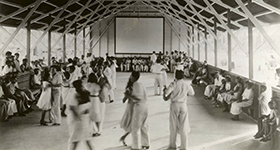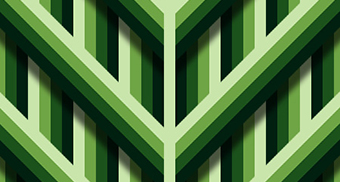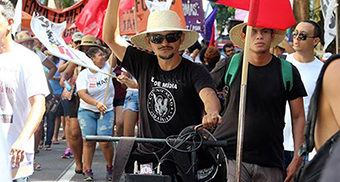Transmissão Fordlândia explores the present conditions and history of Fordlândia, Brazil, through soundscapes and radio systems by local artists and musicians. Deriving inspiration from the Amazon's auditory ecosystem, Northern Brazil's vibrant musical heritage, and Fordlândia's fallen machines, the live broadcasts and month-long listening exhibition will feature site-specific sound works that explore how transit and transmission through river, roads, rubber, and radio shape contemporary ecosystems in the jungle city today.
Fordlândia was founded in 1927 by industrialist Henry Ford on a quest to cultivate a steady rubber supply for his motorcar empire, and was abandoned less than two decades later. Ford?s attempt to colonize and industrialize the Amazon was disastrous from the outset. Single-crop agriculture, North American suburban aesthetics, and Ford-ist labor regulations were met with widespread resistance from workers and nature alike. After years of collapse and veritable abandon, Ford?s jungle towns have been slowly resettled.
Sound artists will work with local communities not only to create new works, but also to reactivate the defunct local FM radio station. In the week leading up to the exhibition, the artists will run community workshops inviting Fordlândia?s residents to participate in sound collection and radio-operation projects, with the aim of reactivating the former station. The opening weekend (September 16 and 17) will include performances, interviews, and soundscapes transmitted live to local and global audiences via the relaunched station and online for global listeners. The listening installation in the former Ford Factory will be open to the public through October 14. The new radio transmitter and local station will stay behind and continue to be activated by the community.
Fordlândia was founded in 1927 by industrialist Henry Ford on a quest to cultivate a steady rubber supply for his motorcar empire, and was abandoned less than two decades later. Ford?s attempt to colonize and industrialize the Amazon was disastrous from the outset. Single-crop agriculture, North American suburban aesthetics, and Ford-ist labor regulations were met with widespread resistance from workers and nature alike. After years of collapse and veritable abandon, Ford?s jungle towns have been slowly resettled.
Sound artists will work with local communities not only to create new works, but also to reactivate the defunct local FM radio station. In the week leading up to the exhibition, the artists will run community workshops inviting Fordlândia?s residents to participate in sound collection and radio-operation projects, with the aim of reactivating the former station. The opening weekend (September 16 and 17) will include performances, interviews, and soundscapes transmitted live to local and global audiences via the relaunched station and online for global listeners. The listening installation in the former Ford Factory will be open to the public through October 14. The new radio transmitter and local station will stay behind and continue to be activated by the community.
Artist Agustina Woodgate and curator Stephanie Elyse Sherman are part of a collaborative called RADIOEE which also includes designer Sebastian Bellver and activator Hernan Woodgate. RADIOEE hosts nomadic, multilingual online radio broadcast events on mobility topics. Adapting to sites languages and cultures in situ, RADIOEE opens a channel that cultivates local voices music and sound experiments and connects them with global listeners. For Transmissão Fordlândia, RADIOEE collaborated with producer Mat Guzzo and curator Ruli Moretti.
Guzzo is a visual artist producer and transdisciplinary researcher who handled the complex logistics of navigation production and Fordlândia radio re-activation. Moretti is a Belém-based independent curator and cultural manager who worked on the ground with the artists to guide resonance of the exhibition projects within the broader Brazilian/Amazonian context and the Fordlândia community.





